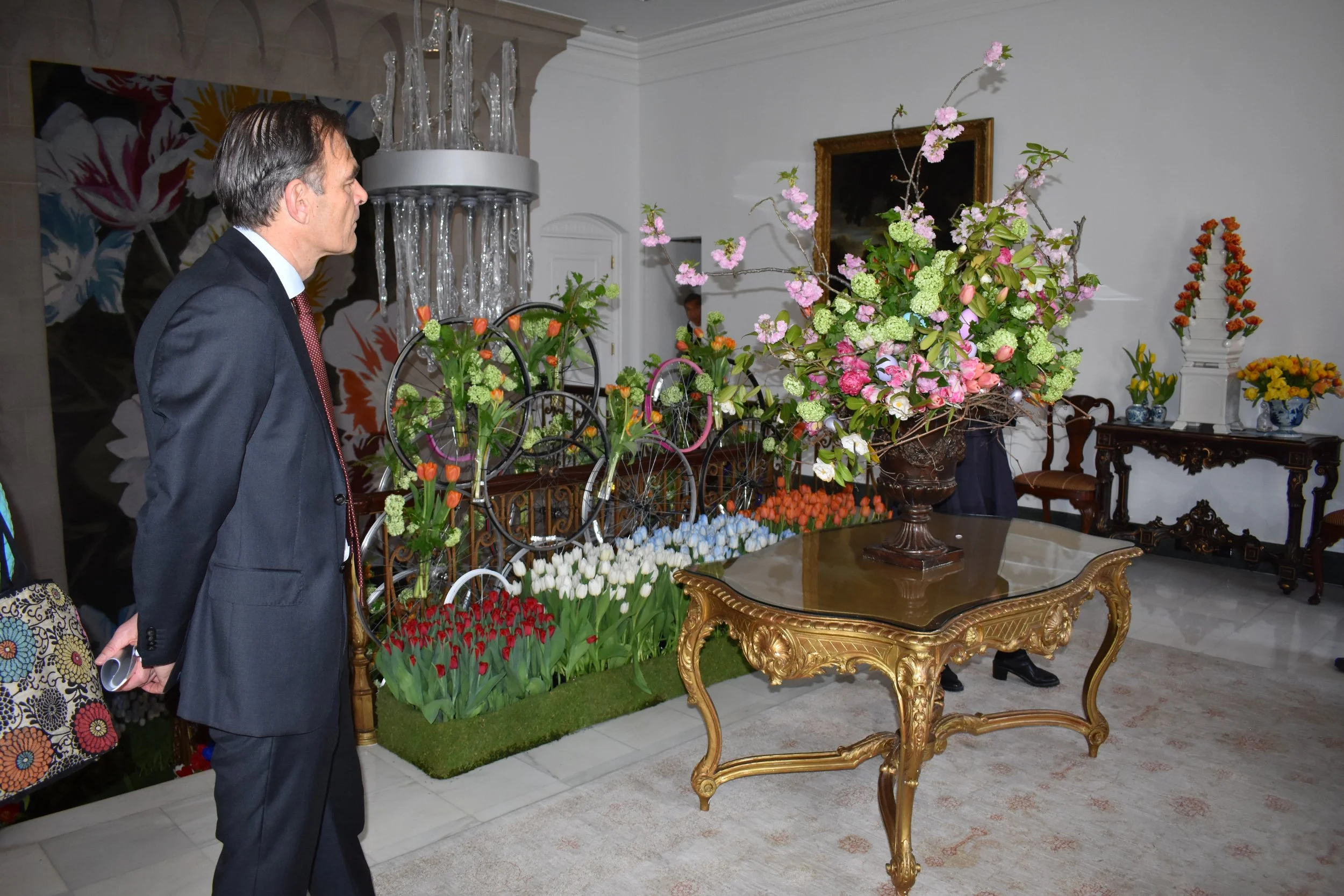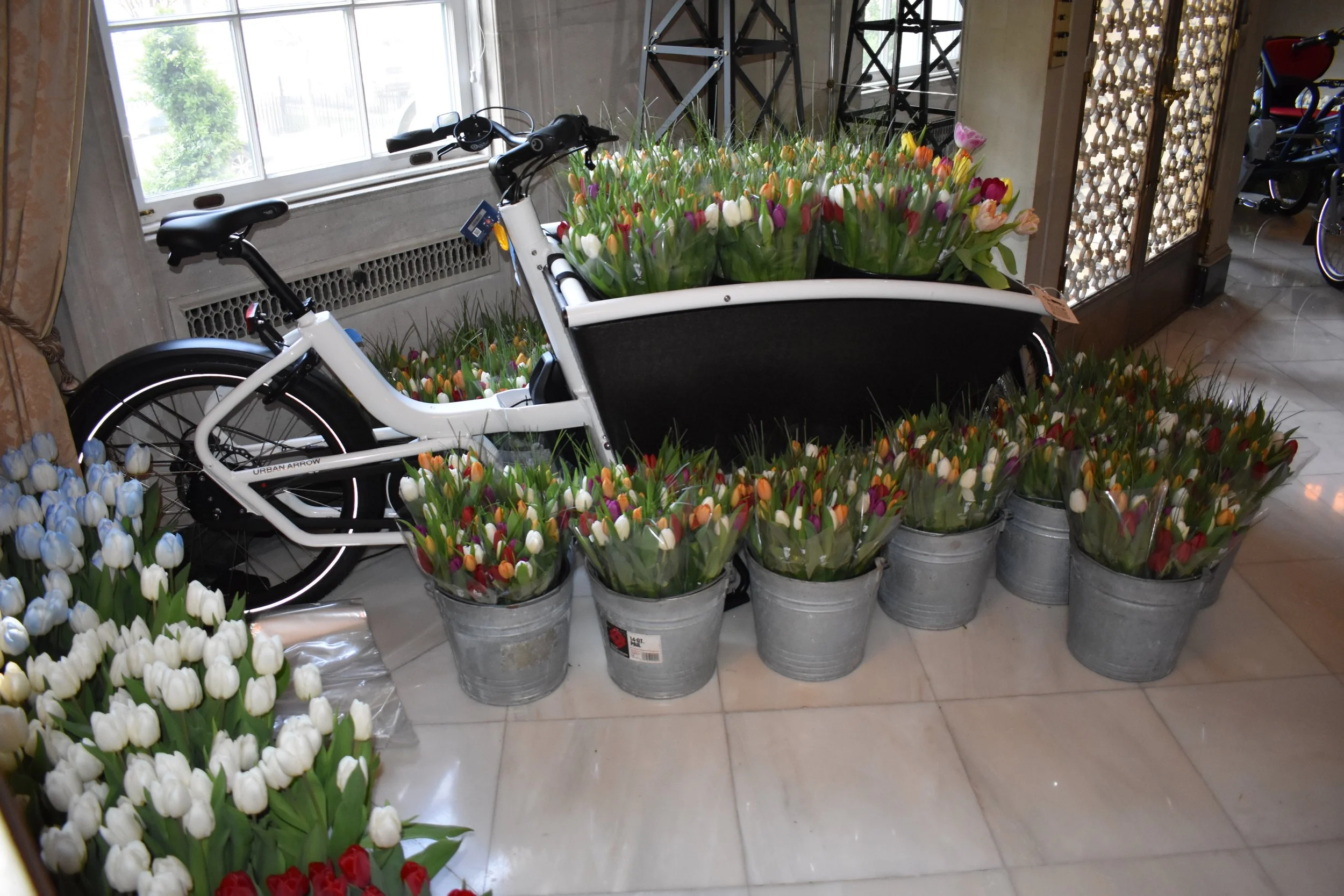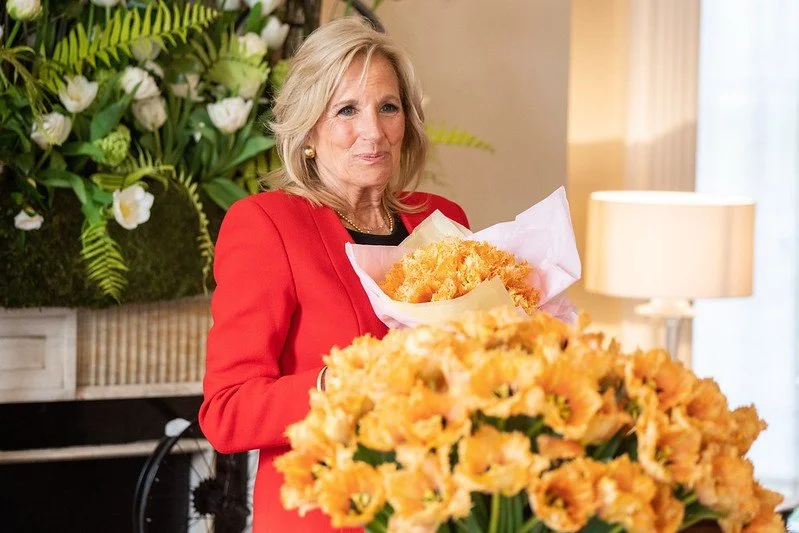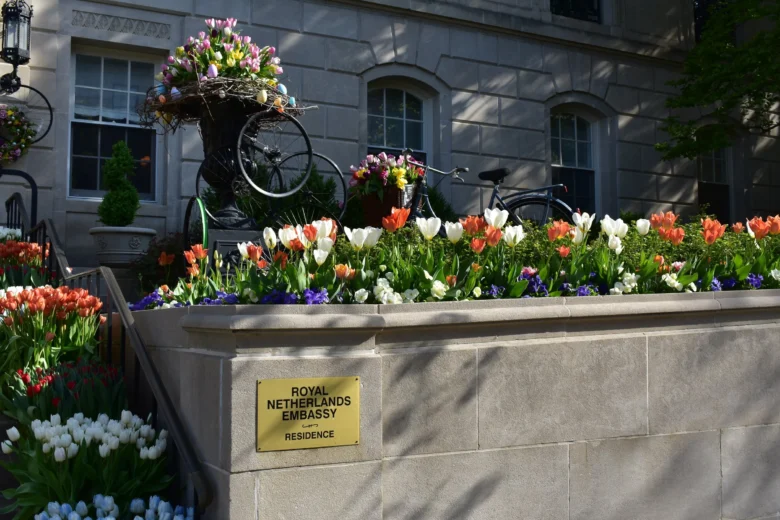“There are flowers,” writes Michael Pollan, “and then there are flowers: flowers, I mean, around which whole cultures have sprung up, flowers, with an empire’s worth of history behind them, flowers whose form and color and scent, whose very genes carry reflections of people’s ideas and desires through time like great books.”
Each year about this time, I think of this passage in Pollan’s in The Botany of Desire, one of my favorite books, and his exploration of the explosion of the tulip onto the Dutch landscape, his careful tracing of the roots of the history of “tulipmania” in the 16th century and how the tulip today, so long domesticated, is inexplicably linked with one of the most fundamental of human desires – beauty.
Explosion is the perfect word for the burst of color that reaches me as I walk down S Street in Kalorama, along this stretch of ambassadors’ residences, and the homes of former presidents. More than 15,000 tulips have filled the home of the Netherlands Ambassador and have spilled out onto the lawn, a thoroughly planned, although seemingly spontaneous, riot of beauty that will not, cannot, be contained, within its walls.

Tulips had already been on the Dutch landscape for more than 200 years when the U.S. and the Netherlands formally established diplomatic ties in 1782. However, the country once known as the Republic of the Seven United Netherlands had served a critical role in the American Revolutionary War a few years earlier, when, in 1779, the Continental Congress commissioned Henry Laurens as Minister to the Netherlands to negotiate a treaty between the newly independent United States and the Republic of the Netherlands. Laurens was captured by the British Navy en route to Europe with a draft of the proposal in hand; shortly after, the British declared war on the Netherlands.
The Netherlands became the second nation to formally recognize the independence of the United States when The Hague accepted the credentials of Minister John Adams in April 1782. A Dutch legation was formed in the U.S. in 1783.
Two years later, the United Provinces of the Netherlands was overthrown and replaced with a new regime led by Napoleon Bonaparte’s brother, Louis, as king. John Quincy Adams, John Adams’ oldest son, was assigned as U.S. minister; Adams believed the new republic to be an agent of French power. In 1801, Secretary of State James Madison, citing expense reduction, but really fearing a Napoleon-run Dutch foreign office, closed the U.S. legation in The Hague. It would remain closed until 1814, when the French were defeated, and the Dutch regained independence and full sovereignty.
After the German invasion of the Netherlands in 1940, the U.S. once again closed its legation in the Hague and reopened it in London near the Dutch government-in-exile. During this time, U.S. legation to the Kingdom of the Netherlands was formally elevated to embassy status, when Minister Anthony J. Drexel Biddle Jr. presented his credentials to the government in exile in London on May 8, 1942.
In 1944, the Dutch purchased their residence in Washington.
The following winter, when German forces blocked coal and food supplies to the Netherlands, a famine caused the deaths of tens of thousands. Those who survived did so, in part, by eating tulip bulbs.

On the corner of 24th and S Streets in Kalorama, catty-corner from the home of President Woodrow Wilson (now a historic landmark and a site of the National Trust for Historic Preservation, open to the public) sits the official Royal Netherlands Embassy Residence.
Designed by San Francisco-born architect Ward Brown in the Neoclassical Revival style, the home is a a four-story brick, concrete, and stone home built in 1929 for Chicago-based transit baron Louis J. Owsley at an estimated cost of $90K. Owsley, who died in 1943 and is buried in Rock Creek Cemetery, has been politely described as “descended from a prominent Kentucky family which has sent many of its members into state and national legislatures.” His wife, Dorothy, who predeceased him in 1943, was the daughter of a Confederate captain. (The current generation of the Owsley family maintains a historical society dedicated to their ancestors.) It’s listed in both the Massachusetts Avenue and Sheridan-Kalorama Historic Districts.
Wilmer Bolling, brother-in-law to President Woodrow Wilson, built the home as one of several that would eventually become diplomatic residences, including the Indian residence in Cleveland Park, the French in Kalorama, and the homes of Chief Justice Charles Evans Hughes and Secretary of the Navy Charles Francis Adams on R Street and the mansion of the former Secretary of War Henry Stimson (now the Maret School.) When Bolling died in 1951, he did so at home – just across the street from the Dutch Ambassador’s residence.
Had Bolling lived a few months longer, he would have witnessed a royal visit the likes of which Washington hasn’t seen in decades.
On April 2, 1952, dubbed “Netherlands Day” by the District of Columbia, Queen Juliana and Prince Bernhard received the keys to the city at the beginning of a three-week goodwill tour across the U.S. They were greeted at National Airport by President and First Lady Truman, the Marine Corps Band – one of 19 bands to provide continuous music along the bunting-clad journey from the airport to Pennsylvania Avenue, stopping first in front of city hall to receive the key, then traveling to the White House, ushered along by tiny flag-waving children and tens of thousands of city and federal employees who had been let off early to attend the festivities. Although staying at the White House for the three days of their visit (the Blair House was under construction), the royal couple hosted several receptions for the diplomats and diaspora on S Street.

There was significantly less fanfare on the day I visited but it was clear that something was afoot.
The exhibition was as grand as last year’s. The theme – Dutch Cycling Culture – offered an opportunity to showcase a series of innovative Dutch bicycles, including an Urban Arrow Cargo e-bike, a Van Raam side-by-side tandem bike specifically made for people with disabilities, a DutchFiets bicycle made out of recycled plastic, and a Bough bike made out of sustainably-managed wood, as well as new bike bags designed as part of a campaign to get folks more comfortable with running errands by bike. City Bikes in Tenleytown lent rims to the display; when the embassy returns them, the rims and parts will be donated to the Village Bicycle Project in West Africa. As it does each year, preparations for the April Tulip Days event began last fall.
The Ambassador’s Tulip Days reception is one of the events I build my annual calendar around – I enjoy the showcase of bicycles and flowers so much that I confirmed the date with embassy staff before booking a vacation. Most years I see some familiar faces; the press reception is a rather intimate event. This year, men in the sort of suits that hide weapons and with haircuts that don’t hide earpieces were mingling about, obvious in the way that agents with Secret in their title can be. Although there is no particular threat to the ambassador from those in attendance, they’re not there for him. They’re the advance team.
Later that afternoon, First Lady Jill Biden visited the explosion of tulips at the residence, and was presented a tulip named for her by Ambassador André Haspels. The Tulipa Jill Biden is a reddish orange tulip with fringed petals, and is the eighth tulip named for an American First Lady. The tradition began in the 1800s with Frances Cleveland. The most recent, Laura Bush, accepted hers in 2004. In between, Grace Coolidge, Eleanor Roosevelt, Lady Bird Johnson, Barbara Bush, and Hillary Clinton, have all had tulips named for them.

There’s no doubt a book where such things are written down, where leaves of each tulip named after a First Lady or a royal are carefully preserved, creating a legacy of botanical diplomacy that will last far longer than the flowers themselves, will last as long as the house that keeps it safe.
The tulips themselves, however, are gone in a much shorter time.
“The tulip’s blooms float above nature’s turmoil; even when they expire they do so gracefully,” Pollan writes. “Instead of turning to mush, like a spent rose, or to used Kleenex, like peony petals, the six petals on a tulip cleanly, dryly, and often simultaneously, shatter.”
This profile of the Netherlands Residence was sponsored by Nan Langen Steketee of Philadelphia, Pennsylvania.
